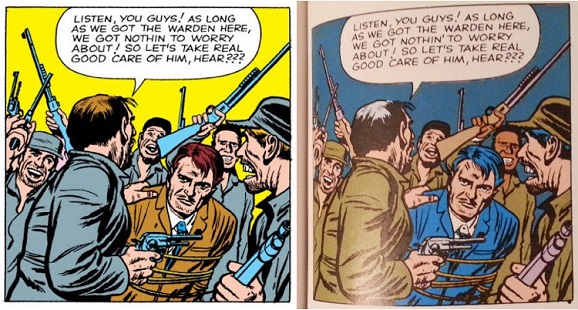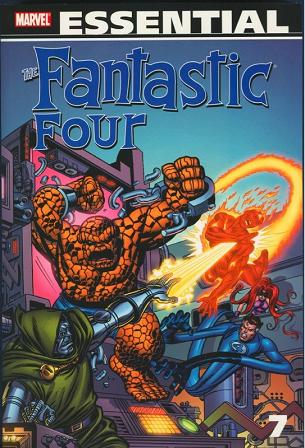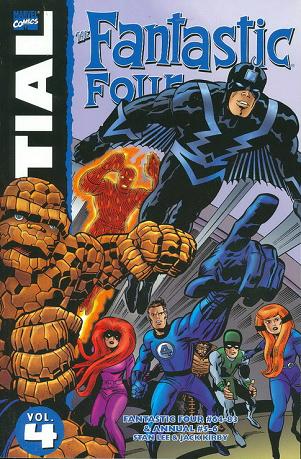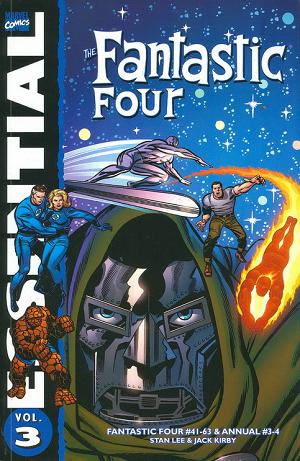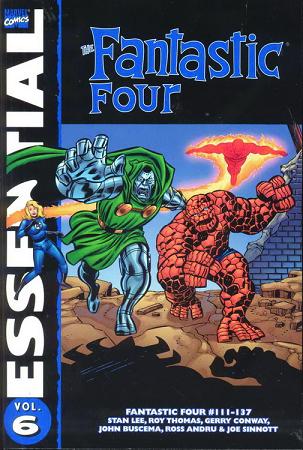
Essential Fantastic Four Vol. 06
Stan Lee, Archie Goodwin, Roy Thomas, John Buscema and friends
Reprints: Fantastic Four #111-137 (June 1971 – August 1973)
Get this for: The Fantastic Four within Kirby or Lee — three stars
Curse my luck! Just as with the Essential X-Men yesterday, I never managed to get volume five of Essential Fantastic Four either, which means I missed the end of the Lee-Kirby run. Instead volume six offers Big John Buscema on art duties, with Stan Lee, Archie Goodwin, then Lee again and finally Roy Thomas handling the writing. Good though these gents are, their work can’t compare to what Jack Kirby brought to The Fantastic Four. Even though Stan Lee himself is still around for a while here, the chemistry he had with Kirby is gone. Kirby and Lee could always spark ideas of each other, now Lee had to do it all himself.
It’s not all bad though. For a start, this volume contains the first Fantastic Four comic I ever read, #113, translated in Dutch as Vier Verdedigers Classics #59 which an uncle had in his collection — and I have now. That issue was the start of the Overmind saga and its cover is burned in my memory. It was not just the first FF comic I read, but must have been one of the earliest superhero comics I ever saw and it fascinated me. It’s a typical late Silver Age Marvel issue, continuing directly from the previous issue, with cameos from the Hulk and Agatha Harkness and a guest star appearance by the Watcher, while the action never stops, all drawn in that wonderful expressive, larger than life John Buscema style and it’s just crack to a certain kind of geek boy (or girl) like me. It may not have been half as good as what Lee and Kirby had been up to before, but I didn’t know anything about that.
The whole Overmind story showed that some of the creativity of that earlier run was still present in The Fantastic Four, as the Overmind turned out to be the last living survivor of an ancient alien race, the Eternals, scource of the cosmos, who had conquored all before them until they reached the planet Gigantus, which dwarved Galaxies and was their doom. As the Eternals’ own planet died beneath them, they put all their mental power into the Overmind and send him into the universe to sleep and wait until the time was right for the Overmind to come from beyond the stars and crush the universe! The Fantastic Four are helpless before him, even need to teamup with Doctor Doom to fight him but even that is not enough, though Doom does get his crowning moment of awesome as he fights an unequal battle with the Overmind but keeps standing for he is … DOOM! In the end though it’s the Stranger, revealed to be the combined might of the people from Gigantus who tames the Overmind.
The Overmind is however the only original villain to fight the Fantastic Four this volume, as for the most part they fight old enemies and even menaces originally introduced in other series. Diablo and Galactus return for rematches, they get involved with the Inhumans again, the Frightful Four come back with a new member, and so on. There are other changes in the status quo though. Roy Thomas lets Sue Richards quit the FF and makes Medusa of the Inhumans her replacement, while the relationship of Johnny Storm and Crystal also ends, as the latter falls for Quicksilver, the mutant Avenger. On the whole The Fantastic Four is much more soap opera orientated then before, less interested in exploration as well, more going for fighting “conventional” villains. It’s not as wild as the Lee-Kirby runs, but it’s far from bad either.
As for the art, John Buscema is as great as Kirby in his own right and I do like the grandeur he gives a character like the Watcher, as well as the body language he gives his characters. A more conventional artist than Kirby perhaps, but you can hardly fault him for that. I love how he poses his characters, the stances he gives them which betray their emotions and character. Every now and again, often in just some small throwaway panel I just have to stop and study his art, bask in it.
A letdown after the sheer mastery of the first four Essential Fantastic Four volumes? Perhaps, but Buscema’s art and the efforts of Lee, Goodwin and Thomas make up for a lot.
